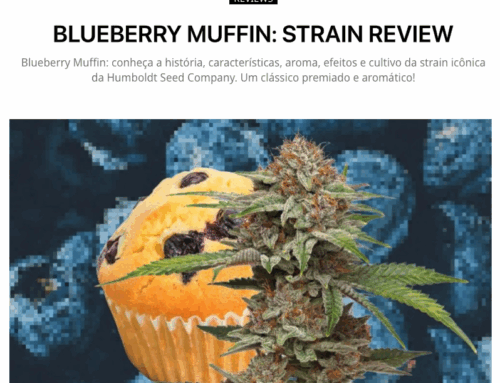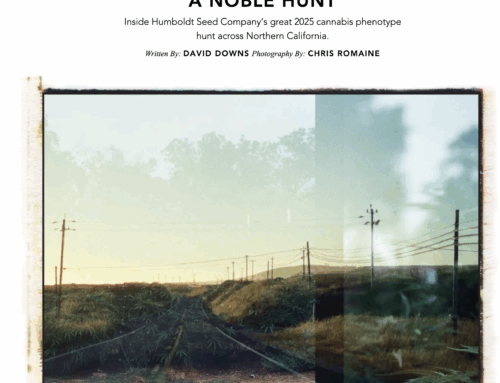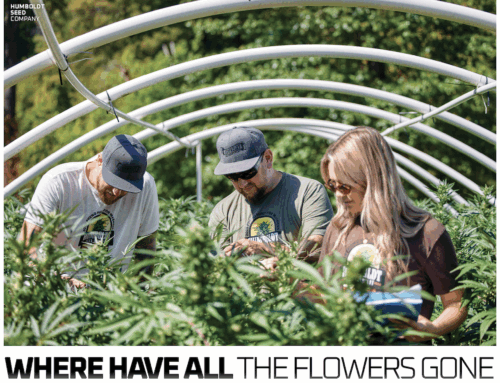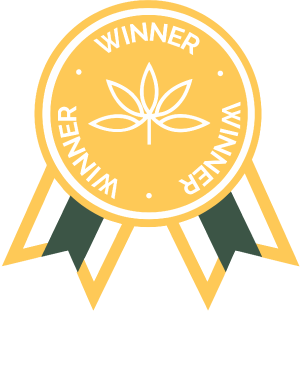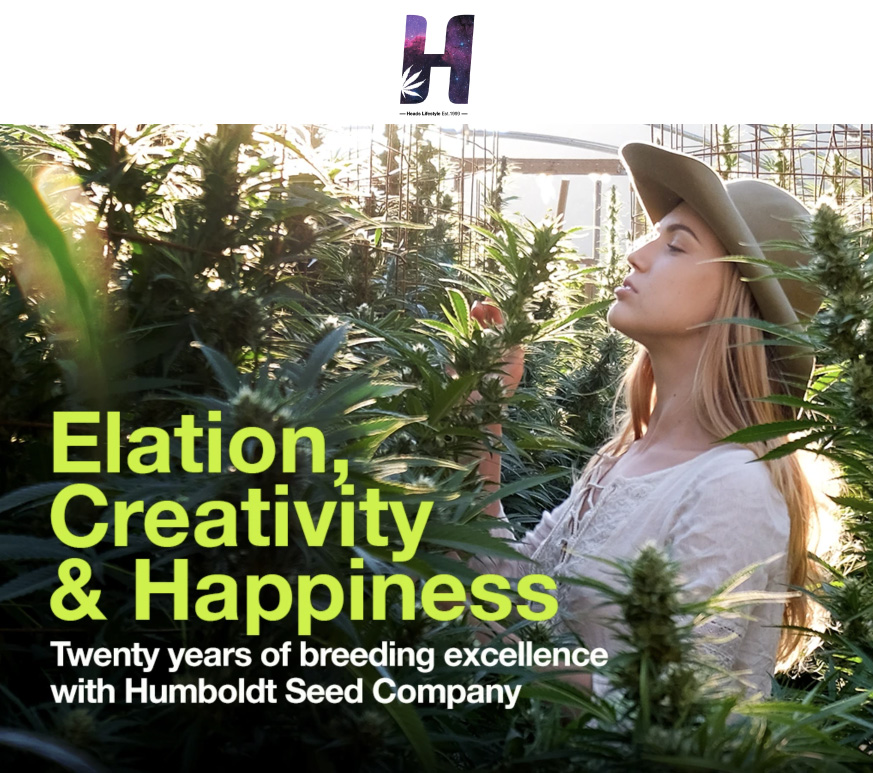
Twenty years of breeding excellence with Humboldt Seed Company
Imagine holding the genetic secrets to the world’s greatest cannabis strains. Heads Lifestyle caught up with Nat Pennington, Co-founder of Humboldt Seed Company, who for the last 20 years has been creating a legacy catalogue of heirloom cannabis strains while developing exciting new varietals with an eye on the elusive “unicorn” prize.
Heads Lifestyle: How is life on the Humboldt Seed farm?
Nat Pennington: Busy as always. We are always exploring and going deeper into the world of phenotypes.
HL: How many strains does Humboldt Seed Company currently produce? How do you come up with the original names for your new strains?
NP: We try to maintain 40-50 at any given time. Some may be available in feminized, some in autoflower, some in regular, and we also have hemp CBD seeds as well. Naming has become more of a challenge, as there seems to be a rush on folks assigning names to things that may not have longevity and staying power. It’s so easy to take a male and a female and have them near each other, and come up with something that may look unique, but in many cases the resulting strain wasn’t developed carefully in a way that allows it to stand out. So, then a name gets slapped on it, and the code of cannabis ethics says you can’t use that name for anything else. Some great names get taken out of the mix this way. We try and have fun with the naming and have the ones we come up with reflect a positive vibe. It’s a team effort. We bounce ideas off each other and eventually something sticks.
HL: Humboldt Seed Company is 100% carbon neutral and self-sustaining with solar and micro-hydroelectric power. What led you to these decisions for your farm?
NP: Most of the original group—Ben Lind and myself—have a background in science. If you understand science, you understand the dire situation we are in. We feel that when science shows you the way, you follow the science and make decisions that you know need to be made. It was a no-brainer for us. It’s just the right thing to do.
HL: Tell us about Clean Green certification and why cannabis cannot legally be called “organic”? What is Humboldt Seed Company’s position with regard to organic farming?
NP: Everything we grow and produce is 100% organic. The term organic can get a bit sticky, as the term “organic” is now owned by the federal government, so they regulate whether things can bear the organic label. Since the feds do not yet recognize the legality of cannabis in legal states, we are not able to label our products as organic, even though we’ve always used strictly organic amendments. People assume because California has stringent pesticide regulations that it’s all organic, but in reality you can use as many chemical fertilizers as you want and still pass the CA tests. You can use Miracle Grow and still pass the tests. So, really it’s a good idea to know where your products come from and buy from trusted sources. The Clean Green Certified seal gives consumers something they can look for.
Heads Lifestyle: Humboldt Seed Co 1
Owner and CEO of Humboldt Seed Company, Nat Pennington.
HL: Is there a significant difference between what medical and recreational users are looking for in their cannabis?
NP: California has for all intents and purposes merged the two. We try whenever possible to give price breaks for medical. Being a seed company, we are big proponents of consumers having access to grow their own medicine. In a lot of the medical use states, people who have medical cards are able to grow their own medicine. Sweet Annie and Willie G’s, as well as the CBD Hemp seeds from our partnership with the Yurok are all medical. Blueberry Muffin turned out to have anti-anxiety effects. Sometimes there is crossover. Many enjoy Blueberry Muffin for its pleasant effects, even if they are just recreational users, but many people with anxiety report it’s really helpful medically for them. A lot of people who used cannabis back in their high school or college days and are a bit older now find some of today’s high-THC strains to be a bit too much. Those folks tend to gravitate toward the high-CBD varieties. These can help with the inflammation from arthritis and also tend to produce pleasant, calming effects.
HL: For the novice consumer who has not experienced the cornucopia of different strains, what is your advice for deepening their understanding and experience of cannabis?
NP: I would say try a lot of different varieties. Growing your own is a fun and cost-effective way to try different strains and see what they look like, smell like, and feel like, and to discover how they work for you. Growing your own also has a destigmatizing effect. When you work with the different varieties in the garden, you realize that they are just plants with great properties!
I think the most special moments for me from the pheno hunt are those moments of collaborating with individuals from varied backgrounds, with the common goal of identifying something new and special—a true unicorn!
HL: Let’s talk about the Phenotype Mega Hunt. It sounds epic and on the cutting-edge of cannabis genetics. There were some truly fantastic moments in the video and we were wondering what stood out most for you?
NP: Every professional plant breeder knows the secret is looking through really large populations, but you also need to know what it is you’re looking for. I think the most special moments for me from the pheno hunt are those moments of collaborating with individuals from varied backgrounds, with the common goal of identifying something new and special—a true unicorn.
We had people from every facet of the industry—dispensary owners, farmers, nursery proprietors, avid consumers, geneticists, laboratory owners and technicians, and experts in bioinformatics. We even had world-famous Reggae music artists, the original experts. The group looked at over 3000 individual plants, and used a phenotype rating system to categorize individual traits. It was amazing to see the majority in this varied group choose the same plant. It was a real convergence of experience and intuition coming together. A beautiful thing!
Humboldt Seed Company and Dark Heart Nursery’s Phenotype Mega Hunt.
HL: Benjamin Lind, COA and Co-founder of Humboldt Seed Company, describes the new new: “Smells that haven’t been smelled before and flavours that haven’t been tasted, highs that haven’t been felt.” Tell us about these highs that haven’t been felt before? We’re curious!
NP: It’s all about elation, creativity, and happiness. Sometimes we’re not sure if it’s the new strain we just created, or if it’s just that we are so excited about this work that we do. Probably both. We are trying to move away from what we call the paranoia molecule. Creating strains that don’t cause paranoia, like Blueberry Muffin, is really important to us. We want to target the desirable effects, and minimize the undesirable ones. Bringing something fresh and colourful to consumers is important to us, and also staying true to our motto of keeping the good vibes flowing. It’s in our genetics; it’s in the music we play around the farm. We really feel cannabis can be uplifting and powerful. We take creating something new very seriously, and are always looking to offer novel experiences and the highest quality genetics.
HL: Dan Grace, owner and CEO of Dark Heart Nursery, discusses the future of your collaborative efforts: “The varieties of cannabis that will come out in the next ten years will blow away anything that’s ever come out before.” It sounds like the golden age of cannabis is right around the corner and it’s a great time to be a cannabis consumer?
NP: We couldn’t agree more. We really appreciate all the work that Dan does and the capacity they have to get genetics to a large number of people. He has created a superhighway of sorts to get the people what they want! We are big fans.
HL: Dan Egan, owner of Happy Dreams Farm, discusses the “uncommon” especially in terms of terpenes: “I think the terpenes are going to be one of the most important things, so I’ve been trying to aim towards growing for terpenes.” What are terpenes and why are they so important?
NP: Terpenes are flavonoids and esters, and a litany of more obscure components as well that make up the complex flavour profiles that have an undeniable effect on the overall user experience. Often lab tests ignore how relevant terpenes are to the user experience, and we hope to see more deference given to the terpene profiles and associated effects, as the cannabis industry matures and evolves over the coming years. The creative possibilities and different ways of using terpenes are endless. We have created terpene fog for concerts, added terpenes to Lulu’s Chocolates, and even infused a little terpene magic into a perfume being sold at Saks called Fog & Tree.
Science is playing an increasingly important role in the cannabis landscape. With our entire founding team having a background in science, we are big proponents of using what science has to offer in our efforts to develop the best cannabis strains possible.
HL: Dr. Allison Justice talks about how the cannabis industry is a “researcher’s dream.” What role does science play in developing the best possible cannabis?
NP: Science is playing an increasingly important role in the cannabis landscape. With our entire founding team having a background in science, we are big proponents of using what science has to offer in our efforts to develop the best cannabis strains possible. We utilize marker-assisted breeding and do genetic research, not genetic modification, to inform our breeding practices. We use the appropriate scientific methods to get the information and results we need, but combine that with a good old-fashioned sniff test. There is no substitute for a connoisseur’s nose!
HL: Siobhan Darwish, Co-owner of Blessed Coast Farms, states, “It’s really important to keep and preserve those classic Humboldt strains.” What is Humboldt Seed Company doing to ensure heirloom cannabis strains that have been passed down from generation to generation aren’t lost?
NP: One of the ways we preserve heirlooms is by keeping them in our seed catalogue. Even if they are not the trendy, hot item of the moment, we feel they are classics and have the staying power to be relevant in the long term. We’ve got Trainwreck, Jack Herrer, and one of our originals PPD that has been around long enough to be considered heirloom. Lemon Kush and Purple Mountain Majesty are another two we are committed to keeping in the mix.
HL: Lisa Holland from KindPeoples Genetics gets nostalgic as she describes her personal unicorn: “I’m getting bananas. I’m getting jasmine. I’m getting pear blossoms. It’s bringing me right back to my nonna’s garden.” For the uninitiated, it may come as a surprise that cannabis connoisseurs speak a similar language to wine aficionados.
NP: Lisa has a real passion for the variety we find in cannabis, and she interacts with consumers every day at the dispensary. She does a great job educating the public on the sheer vastness of choice in the cannabis universe. We love her enthusiasm, and she is hands down one of our favourite cannabis sommeliers!
Heads Lifestyle: Humboldt Seed Company 2
COA & Co-Founder of Humboldt Seed Company, Benjamin Lind seeking smells that haven’t been smelled before. Photo: Mike Rosati
HL: You have been breeding cannabis with care and thought for over 20 years. This is testament to the fact that it takes time to develop an expertise and build a quality company. How does your business philosophy differ from the new wave of Big Canna who often launch with powerful investment financing but little practical cannabis knowledge?
NP: Fortunately, we launched over a long period of time and have had the luxury of growing organically and not needing to take on investors. We feel incredibly fortunate to be in this position. We have watched many of our peers struggle with striking the balance between the need for growth and the desire to stay true to their original mission. Taking the slow approach that we’ve been able to take has really allowed us to stay true to our roots, while at the same time embracing the growth necessary to succeed in the competitive marketplace. It’s been a little like the slow business equivalent of the slow food movement. Healthier for people, and the planet.
HL: How long does it take to bring a new seed strain to market—from brainstorming to making it commercially available?
NP: We really appreciate this question. It can take upwards of 1 to 2 years. We pride ourselves on the fact that when we discover a new varietal during a pheno hunt, we take our time and follow up this initial discovery with generations of inbreeding to stabilize the genetics. We want our Blueberry Muffin to smell exactly the same every time, giving people that hit of freshly baked blueberry muffins coming straight out of the oven.
If people don’t take the time to shop local and think about what is going into the cannabis they purchase, whether it’s chemical fertilizers or billion dollar hedge funds, it’s likely we will lose our small family farms.
HL: Yum! Sounds fantastic! You have raised the alarm regarding the corporate takeover of the cannabis industry. What can conscientious consumers do?
NP: If people don’t take the time to shop local and think about what is going into the cannabis they purchase, whether it’s chemical fertilizers or billion dollar hedge funds, it’s likely we will lose our small family farms. The fate is really in the hands of consumers. They wield a tremendous amount of power when it comes to what the cannabis craft market will look like in the future. Educating the consumer is really important for this reason. People need to understand what goes into what they are consuming, and then be willing to make purchasing decisions accordingly.
HL: The Food and Agricultural Organization of the United Nations (FAO) estimates that since the beginning of this century about 75 percent of the genetic diversity of agricultural crops has been lost, including many native land races, as a result of industrialized agriculture. Do you fear a future in which a company like Monsanto would control all of the cannabis genetics?
NP: Yes. I do have concerns, however the cannabis space is likely to be more resilient to that kind of capitalism. The biotech industry has not shown itself to be the most nimble. Their cash cow has been large monocrops, and genetic engineering is time-consuming and resource-intensive. Their offerings don’t change very quickly. We’ve seen how fickle cannabis consumers are and the market demands novelty each season. Nobody wants to smoke a monocrop! Quite possibly big biotech may end up dominating the hemp sector, which is really more about commodity agriculture, but cannabis does not lend itself well to being a commodity-type crop.
Heads Lifestyle: Humboldt Seed Company 3
A family affair—Nat with daughter Halle Pennington.
HL: What needs to be done to sustain a viable legal cannabis industry?
NP: Initiatives like the one we have put forward for mandatory labelling of GMO cannabis are needed. This project is on a bit of a hiatus due to the COVID-19 crisis, but we hope to continue on with it soon. Having real and meaningful organic certifications are key to consumers being able to easily differentiate a corporate commodity from the good stuff. The black market distribution network is so vast, that it will continue unfettered simply because cannabis is the most consequence-free recreational drug out there. A heavily regulated and taxed white market will ensure the black market is alive and well. If state regulators want to see the white market flourish and the black market diminish, they will need to embrace reducing taxes for legal producers.
HL: You talk about needing on-point genetics in order to make it in the competitive cannabis market. Where is most of your competition coming from?
NP: Ironically, a lot of the competition comes from the cities, like Los Angeles. It’s easier to market and hype your product when you’re right there in the thick of it. That said, Humboldt County has the most acreage dedicated to cannabis growing in the largest cannabis economy in the world, so this is definitely where the action is.
Having real and meaningful organic certifications are key to consumers being able to easily differentiate a corporate commodity from the good stuff.
HL: What is the greatest obstacle facing California’s legal cannabis producer?
NP: Without a doubt, we have to take a look at the taxes imposed on legal cannabis businesses. California, in particular, really made a mistake with the combination of a high barrier to entry, strict regulations and excessive taxes. This has made it really difficult for legal producers to compete. You can only drop your price so much, and stay on top of all the expenses required to operate. There was a robust medical marketplace before Prop 64, and the resulting regulatory structure has led to what some call the black market, but what I like to refer to as the grey market. This market is alive and flourishing. California regulators have since identified the problem, and have been working to actively reduce taxes. Even with the lacklustre start to regulatory changes that can address some of these issues, the regulators will ultimately figure it out. At the end of the day, people want to purchase safe, tested products, free from pesticides and other harmful chemicals. Anything like this involving government regulation just takes time and requires an inordinate amount of patience.
HL: What’s it going to take for the craft cannabis market to succeed?
NP: Consumers becoming more educated, like we saw happen when craft beer emerged. The consumer has to notice that every grocery store has Coors, before they realize that it’s not handcrafted and what they are really getting is a giant corporate beer. Another thing that we see happening is people get tired of smoking the same strains, and they are looking for something new and different. Companies can set themselves apart by working with breeders who are developing unique and interesting genetics. Then through effective marketing, they can signal to the consumer that their weed is not commodity weed, but craft weed.
Heads Lifestyle: Humboldt Seed Company 4
Blueberry Muffin—smells like freshly baked blueberry muffins coming straight out of the oven.
HL: Ultimately, Humboldt Seed Company is a business. Can you successfully produce seeds for both the backyard gardener and the larger farms?
NP: Honestly, we enjoy producing seeds for the mom and pop and backyard grows as much or more, but our focus is simply breeding the best cannabis we can, and fortunately that works well in the backyard and on the acres and acres.
HL: We love the videos on your website describing each strain. You’re a natural in front of the camera. Do you see yourself, one day, moving into education or consulting?
NP: Funny you should ask. Before it was possible to be a full-time cannabis seed company owner, I was a biologist and educator. I worked as a fisheries biologist and environmental educator. One of the aspects of the job I enjoyed the most was working with kids programs at the local grade schools here in Humboldt County. I have also enjoyed consulting for different cannabis operations, especially the ones in Jamaica that I’ve worked with.
HL: As a recognized cannabis expert, we’d love to tap into your personal experience. What is your favourite strain for…
1) Relaxing?
NP: Blueberry Muffin
2) Socializing?
NP: Lemongrass
3) Feasting?
NP: Vanilla Frosting
4) Romance?
NP: Stupid Fruits
5) Listening to music?
NP: The Bling
6) Getting Creative?
NP: Our new strain Vanilla Cream Pie
7) Moving/sports?
NP: Trainwreck
HL: What is your favourite way to consume?
NP: Joints or bong hits.
HL: Is Humboldt Seed Company a family affair? What do you hope to pass on to the next generation?
NP: Yes, it absolutely is both in blood and in spirit. Ben’s family has a long history of growing up in the Appalachian Mountains. His aunt and uncle passed down their knowledge to him over the years. My daughter, Halle works full-time as a product executive at the company. We hope to pass on the real Humboldt cannabis culture, which prioritizes community, ecology, and social justice.
Heads Lifestyle: Humboldt Seed Company 5
Humboldt Seed Company product executive Halle Pennington.
HL: Please tell us about the community initiatives Humboldt Seed Company is involved in?
NP: Six years ago, we co-founded Nature Rights Council, a non-profit whose mission is to ensure a sustainable future through advocacy, education, and social change emphasizing traditional ecological knowledge. The organization has grown to have several programs under one umbrella, with the most active being the Ancestral Guard. This is a Native American youth-led project that focuses on our region’s sustainable food webs, with an emphasis on Native tradition and Native autonomy. An exciting recent development is the removal of the Klamath Dams for salmon restoration. This is a project we’ve been involved with since its inception in the late 1990s, and has been described by National Geographic as the world’s largest river restoration effort.
HL: Wow! That’s impressive. Do you have any other passions?
NP: White water rafting and salmon restoration and research. We have lived on the river for many years, so everything seems to revolve around that. It’s a powerful force.
HL: Do you have a farm mascot?
NP: We have a turtle, Harold that lives on the farm. He is wild, but spends the majority of his time basking in the Humboldt sun on a little floating island we built for him in our pond.
HL: Do you believe that cannabis will change—perhaps even save—the world?
NP: Well, it has had an incredibly positive effect on my life, so I look forward to seeing what it can do when more people around the world have access to it and can experience it for themselves.
HL: Thank you, Nat, for taking the time to chat with us. Your insight is a real eye-opener and we wish you the best of luck with your future projects.
Lear more about Humboldt Seed Company at: humboldtseedcompany.com
Follow them on Instagram at: @thehumboldtseedcompany
Listen on Spotify
Want to know what’s playing on the sound system at Humboldt Seed Company while the plants grow? Listen to our custom Humboldt Seed Co-curated “Humboldt Seed Co. Mix” on Spotify.

